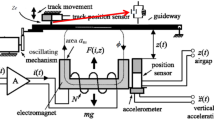Abstract
The maglev trains suffer from various control complexities such as strong nonlinearity, open-loop instability, disturbances and parameter perturbations in the long-term operation of trains, which make the control of magnetic levitation system very challenging. In this paper, an airgap robust control strategy is proposed for a maglev trains. Specifically, the developed controller utilizes backstepping method in conjunction with sliding mode control technology to asymptotically regulate the airgap to a desired trajectory despite parameter perturbations and external disturbance. The nonlinear dynamic model of magnetic suspension system is derived and analyzed. Then, the system is decomposed into two sub-systems. For the first subsystem, the Lyapunov function and inter virtual control variables are designed. The sliding mode surface is constructed in the second subsystem to complete the design of the whole robust control law. The stability of the presented controller is proven by Lyapunov techniques. Finally, results of simulation show the superiority of the proposed control algorithm tackling parameters change and disturbances.
Access this chapter
Tax calculation will be finalised at checkout
Purchases are for personal use only
Similar content being viewed by others
References
Lee HW, Kim KC, Lee J (2006) Review of maglev train technologies. IEEE Trans Magn 42(7):1917–1925
Sun Y, Xu J, Qiang H, Chen C, Lin G (2019) Fuzzy H∞ robust control for magnetic levitation system of maglev vehicles based on T-S fuzzy model: design and experiments. J Intell Fuzzy Syst 36(2):911–922
Thornton RD (2009) Efficient and affordable maglev opportunities in the United States. Proc IEEE 97(11):1901–1921
Boldea I, Tutelea L, Xu W et al (2017) Linear electric machines, drives, and MAGLEVs: an overview. IEEE Trans Ind Electron 65(9):7504–7515
MacLeod C, Goodall RM (1996) Frequency shaping LQ control of maglev suspension systems for optimal performance with deterministic and stochastic inputs. IEE Proc Control Theory Appl 143(1):25–30
Sinha PK, Hadjiski LM, Zhou FB et al (1993) Electromagnetic suspension: new results using neural networks. IEEE Trans Magn 29(6):2971–2973
Sinha PK, Pechev AN (1999) Model reference adaptive control of a maglev system with stable maximum descent criterion. Automatica 35(8):1457–1465
Sun Y, Xu J, Qiang H, Lin G (2019) Adaptive neural-fuzzy robust position control scheme for maglev train systems with experimental verification. IEEE Trans Ind Electron 66(11):8589–8599
Li J, Li J, Zhou D et al (2015) The active control of maglev stationary self-excited vibration with a virtual energy harvester. IEEE Trans Ind Electron 62(5):2942–2951
Morales R, Feliu V, Sira-Ramirez H (2011) Nonlinear control for magnetic levitation systems based on fast online algebraic identification of the input gain. IEEE Trans Control Syst Technol 19(4):757–771
Sun Y, Xu J, Qiang H, Wang W, Lin G (2019) Hopf bifurcation analysis of maglev vehicle–guideway interaction vibration system and stability control based on fuzzy adaptive theory. Comput Ind 108:197–209
Wu SJ, Wu CT, Chang YC (2008) Neural-fuzzy gap control for a current/voltage-controlled 1/4-vehicle maglev system. IEEE Trans Intell Transp 9(1):122–136
Wai RJ, Lee JD (2008) Adaptive fuzzy-neural-network control for maglev transportation system. IEEE Trans Neural Netw 19(1):54–70
Sun Y, Xu J, Qiang H, Chen C, Lin GB (2019) Adaptive sliding mode control of maglev system based on RBF neural network minimum parameter learning method. Measurement 141:217–226
Kusagawa S, Baba J, Shutoh K et al (2004) Multipurpose design optimization of EMS-type magnetically levitated vehicle based on genetic algorithm. IEEE Trans Appl Supercond 14(2):1922–1925
Liu C, Rong G (2015) SVM α order inverse system decoupling time-varying sliding mode control of double suspension systems of machining center. China Mech Eng 26(5):668–674
Gang Z, Jian Z, Hai-Long Z et al (2013) Calculation on Magnetic Force for Permanent Magnetic Bearings by Monte Carlo Method Based on Equivalent Magnetic Charge Method. Bearing 10:1–4
Sun Y, Xu J, Lin G, Ji W, Wang L (2020) RBF neural network-based supervisor control for maglev vehicles on an elastic track with network time-delay.IEEE Trans Ind Inform. https://doi.org/10.1109/TII.2020.3032235
Sun Y, Xu J, Wu H, Lin G, et al (2020) Deep learning based semi-supervised control for vertical security of maglev vehicle with guaranteed bounded airgap. IEEE Trans Intell Transp Syst. https://doi.org/10.1109/TITS.2020.3045319
Kuo C et al (2016) Using ground-penetrating radar to promote the investigating efficiency in mud pumping disaster of railways. Proc Eng Technol Innov 4:49–51
Funding
This work was supported in part by the National Natural Science Foundation of China under Grant 51905380 and Grant 52072269, and in part by Shanghai Maglev and rail transit Collaborative Innovation Center.
Author information
Authors and Affiliations
Corresponding author
Editor information
Editors and Affiliations
Ethics declarations
The authors declare no conflict of interest.
Rights and permissions
Copyright information
© 2022 The Author(s), under exclusive license to Springer Nature Singapore Pte Ltd.
About this paper
Cite this paper
Sun, Y., Xu, J., Xu, H., Cai, W., Lin, Gb. (2022). Backstepping Sliding Mode Control for Magnetic Suspension System of Maglev Train with Parameter Perturbations and External Disturbance. In: Jing, X., Ding, H., Wang, J. (eds) Advances in Applied Nonlinear Dynamics, Vibration and Control -2021. ICANDVC 2021. Lecture Notes in Electrical Engineering, vol 799. Springer, Singapore. https://doi.org/10.1007/978-981-16-5912-6_19
Download citation
DOI: https://doi.org/10.1007/978-981-16-5912-6_19
Published:
Publisher Name: Springer, Singapore
Print ISBN: 978-981-16-5911-9
Online ISBN: 978-981-16-5912-6
eBook Packages: EngineeringEngineering (R0)




